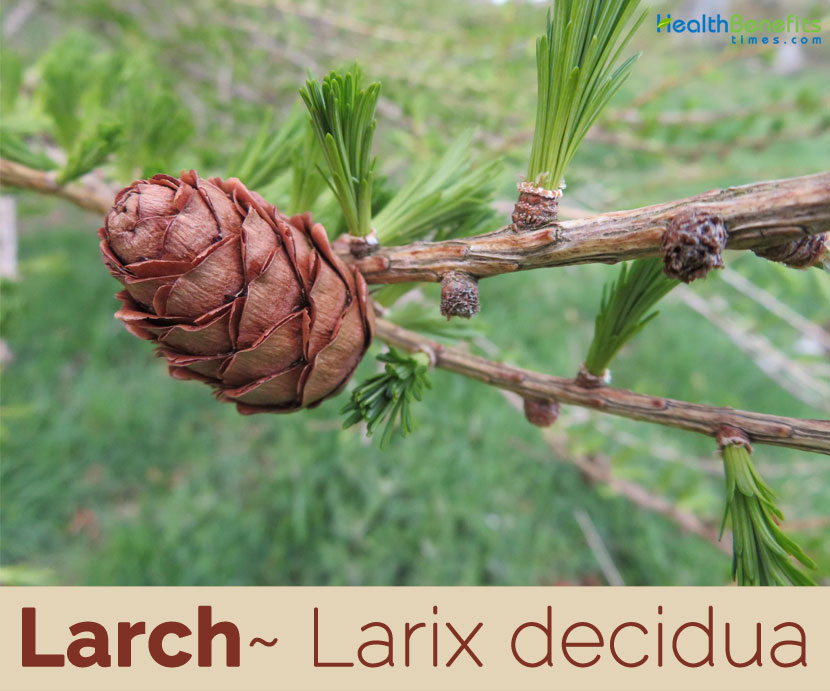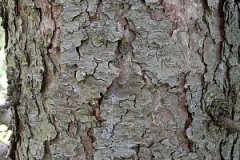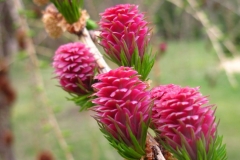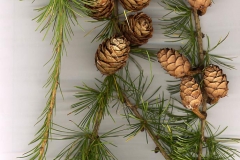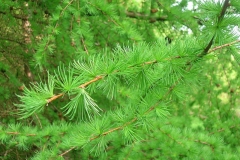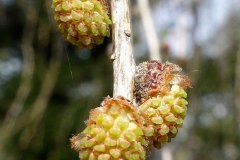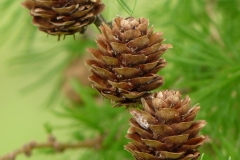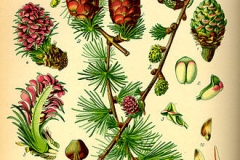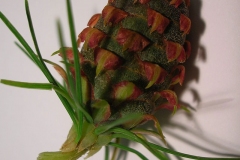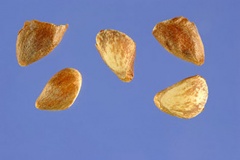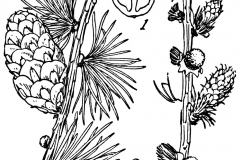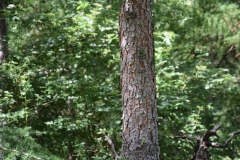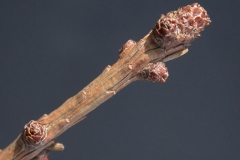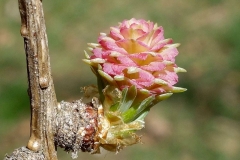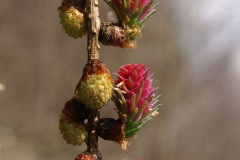| Larch Quick Facts | |
|---|---|
| Name: | Larch |
| Scientific Name: | Larix decidua |
| Origin | Mountains of southern, central and Eastern Europe |
| Colors | Green variably flushed red when immature, turning brown as they mature |
| Shapes | Cones are erect, ovoid-conic, 0.8 to 2.4 inches (2 – 6 cm) long, with 10-90 erect or slightly incurved (not reflexed) seed scales |
| Taste | Astringent |
| Health benefits | Beneficial for rheumatism, bronchitis, diarrhea, asthma, chronic eczema, psoriasis, common cold, flu, H1N1 (swine) flu, ear infections in children, and HIV/AIDS |
| Name | Larch |
|---|---|
| Scientific Name | Larix decidua |
| Native | Mountains of southern, central and Eastern Europe, in the Alps and Carpathian Mountains as well as the Pyrenees, with disjunct lowland populations in northern Poland and southern Lithuania, from southeastern France and south-western Italy to central Romania |
| Common Names | Common larch, European Larch, creosote bush, Larch, white larch |
| Name in Other Languages | Afrikaans: Lariks Albanian: Larsh Amharic: Larch Arabic: Al’arkas shajara (الأركس شجرة), ‘arziat ‘uwrubiya (أرزية أوروبية), KHezhap’ichi yevropakan (Խեժափիճի եվրոպական) Armenian: Khezhap’ichi (խեժափիճի) Azerbaijani: Larch, Avropa qara şamı Basque: Alertzea, Europar laritz Bavarian: Larch Belarusian: Listoŭnica (лістоўніца), Listoŭnica jeŭrapiejskaja (Лістоўніца еўрапейская) Bengali: Larch Bosnian: Ariš Bulgarian: Listvennitsa (лиственица), evropeĭska listvenitsa (европейска лиственица), evropeĭska listvennitsa (европейска лиственница) Catalan: Làrix, làrix europeu, Alerç, Cedre d’olor Cebuano: Larch Chichewa: Larch Chinese: Luòyè song (落叶松), ou zhou luo ye song (欧洲落叶松) Corsican: Larice Croatian: Ariš, Europski ariš, listopadni ariš Czech: Modřín, Modrín opadavý Danish: Lærk, Europæisk lærk Dutch: Lariks, Europese lork, Europese larix English: Common larch, European Larch, creosote bush, Larch, white larch Esperanto: Lariko, Eŭropa lariko Estonian: Lehis, euroopa lehis Filipino: Larch Finnish: Lehtikuusi, Euroopanlehtikuusi French: Mélèze, Mélèze commun, Mélèze d’Europe, pin de Briançon Frisian: Larch Galician: Lariço Georgian: Larch German: Lärche, Europäische Lärche, Gemeine Lärche, europäischer Lärchenbaum Greek: Lárix (λάριξ) Gujarati: Larch Haitian Creole: Melèz Hausa: Larch Hawaiian: Larch Hebrew: לֶגֶשׁ Hindi: Ek prakaar ka vrksh (एक प्रकार का वृक्ष) Hmong: Larch Kurdish (Kurmanji): Larch Hungarian: Vörösfenyő, Európai vörösfenyo Icelandic: Lerki, Evrópulerki Igbo: Larch Indonesian: Larch Irish: Learóg, Learóg Eorpach Italian: Larice, Larice commune, larice europeo, malesu Japanese: Karamatsu (カラマツ), Yōroppakaramatsu (ヨーロッパカラマツ) Javanese: Larch Kannada: Lārc (ಲಾರ್ಚ್) Kashubian: Eùropejsczi skòwrónk Kazakh: Listvennichnyye (лиственничные) Khmer: Larch Kinyarwanda: Larch Komi: Yevropais’ lisven’ (Европаись лисвень) Korean: Nag-yeobsong (낙엽송) Kyrgyz: Karagay (карагай) Latin: Larix Lao: Larch Latvian: Lapegle, Eiropas lapegle Lithuanian: Maumedis, Europinis maumedis Lower Sorbian: Europski larik Luxembourgish: Lärcht Macedonian: Arish (ариш), Evropski ariš (Европски ариш) Malagasy: Larch Malay: Larch Malayalam: Larch (ലര്ഛ്) Maltese: Lerċi Maori: Larch Marathi: Tyācē lākūḍa (त्याचे लाकूड) Mongolian: Shines (шинэс) Myanmar (Burmese): Larch Nepali: Mepal (मेपल) Norwegian: Lerk, Europeisk lerk, Europalerk, Europese lariks, Europese lork, gewone lariks Occitan: Mèlze Odia: Larch Pashto لارچ Persian: کاج اروپایی, سیاهکاج اروپایی Polish: Modrzew, Modrzew europejski Portuguese: Larício, Lariço-europeu Punjabi: Lāraca (ਲਾਰਚ) Romanian: Larice, zada Russian: Listvennitsa (лиственница), Listvennitsa yevropeyskaya (Лиственница европейская) Samoan: Sulu Serbian: Evropski ariš (Европски ариш), arish (ариш) Sesotho: Larch Shambala: Evropski ariš Shona: Larch Sindhi: گهڻو ڪر Sinhala: Larch Scots Gaelic: Learag Serbian: Arish (ариш) Slovak: Smrekovec, Smrekovec opadavý Slovenian: Macesen, navadni macesen Somali: Larch Spanish: Alerce, Navadni macesen, Alerce común, alerce blanco, alerce de Europa, alerce europeo, lárice, melis Sundanese: Larch Swahili: Larch Swedish: Lärkträd, Bergtall, Contortatall, Europeisk lark, Sitkagran, Vitgran, Euroopanlehtikuusi, Lärk, Lärkträd Tatar: Kabıgı (кабыгы) Tajik: Larch Tamil: Ilaikaḷ koṇṭa mara vakai (இலைகள் கொண்ட மர வகை) Telugu: Larc (లర్చ్) Thai: T̂ns̄n chnid h̄nụ̀ng (ต้นสนชนิดหนึ่ง) Turkish: Karaçam, Avrupa melezi, Katran ağaci Turkmen: Garynja Ukrainian: Modryna (модрина), Modryna yevropeysʹka (Модрина європейська) Upper Sorbian: Europski larik Urdu: Larch Uyghur: Larch Uzbek: Tilog’och Vietnamese: Cây sồi Welsh: llarwydd, Llarwydden Ewrop Xhosa: Larch Yiddish: Lartsh (לאַרטש) Yoruba: Larch Zulu: Larch |
| Plant Growth Habit | Pioneer, very long-lived, fast-growing, medium-size to large deciduous coniferous tree |
| Growing Climates | Man-made or disturbed habitats, forests, shrub lands, thickets, woodland borders, moist meadows, edges of yards, roadsides, and abandoned homesteads |
| Soil | Grows best on uniformly moist, deep, fertile, well-structured and aerated soils. It does not do well on pure sand. Preferred soil textures include loamy sands, loams, and silty loams. It can also grow on shallow stony soils, including calcareous soils, with a medium ground water level |
| Plant Size | 25–45 m tall, with a trunk up to 1 m diameter (exceptionally, to 53.8 m tall and 3.5 m diameter) |
| Bark | Bark of young trees is thin, smooth, developing fissures as it matures. On older trees the bark is very flaky and heavily ridged with wide fissures |
| Trunk | Monopodial, straight or curved at base in slopes, with a diameter of 1-1.5 (2)m and fissured bark from reddish brown to light grey |
| Twigs | Twigs slender to stout, flexible to stiff, pale yellow to tan, glabrous or very slightly pubescent, the stubby short shoots cylindrical and 3-10 mm long |
| Leaf | Needle-like, light green, 2–4 cm long which turn bright yellow before they fall in the autumn, leaving the pale yellow-buff shoots bare until the next spring |
| Flowering season | April to May |
| Flower | It produces individual male and female flowers on a same tree. Male flowers are arranged in globular clusters composed of creamy-colored anthers. They grow from the bottom side of shoots. Female flowers consist of clusters of scales that develop on top of shoots. They can be white, pink or green colored |
| Fruit Shape & Size | Cones are erect, ovoid-conic, 0.8 to 2.4 inches (2 – 6 cm) long, with 10-90 erect or slightly incurved (not reflexed) seed scales |
| Fruit Color | Green variably flushed red when immature, turning brown as they mature |
| Seed | Seeds are 4-5mm long, greyish in color |
| Propagation | From stem cuttings |
| Taste | Astringent |
| Plant Parts Used | Bark, Young Shoot, resin, needles |
| Lifespan | About 600-800 years in optimal conditions, but some can live for up to 1000 years |
| Season | October to November |
| Culinary Uses |
|
Plant Description
Larch is a pioneer, very long-lived, fast-growing, medium-size to large deciduous coniferous tree that normally grows about 25–45 m tall, with a trunk up to 1 m diameter (exceptionally, to 53.8 m tall and 3.5 m diameter). The plant is found growing in man-made or disturbed habitats, forests, shrub lands, thickets, and woodland borders, and moist meadows, edges of yards, roadsides and abandoned homesteads. It grows best on uniformly moist, deep, fertile, well-structured and aerated soils. It does not do well on pure sand. Preferred soil textures include loamy sands, loams, and silty loams. It can also grow on shallow stony soils, including calcareous soils, with a medium ground water level.
It is a light-demanding species; larch loses in competition with other trees. Additionally, it can tolerate very cold temperatures during winter. The crown of young trees is symmetrical, open, and narrowly conic becoming broad with age; the main branches are level to upswept, with the side branches often pendulous. The shoots are dimorphic, with growth divided into long shoots (typically 10–50 cm long) and bearing several buds, and short shoots only 1–2 mm long with only a single bud. Old trees often have large, buttressed low branches that run level for 8 to 10 feet (2.4-3 m) before turning upward. European larch is considered as deep-rooted. First year twigs are straw-colored to tan, turning grayish brown, bark becoming rough with brownish gray flaky scales. The crown is irregularly pyramidal, the branches on older trees often drooping. The trunk can reach 3 feet or more diameters at breast height (dbh).
Leaves
First-year twigs (typically 4-20″ long) are pale yellow with alternate leaves, while second-year twigs are gray to grayish brown with clusters of 30-60 leaves. Both types of leaves are about 0.8 to 1.6 inches (2 – 4 cm) long, needle-like in shape, and deciduous. During the spring, the leaves are light green, but they later become darker during the summer. During the fall, they turn yellow before falling to the ground. On second-year twigs, the leaf clusters are produced on short spur-twigs less than 1/8 (3 mm.) long. In each cluster, the leaves are joined together at the base, from which they spread outward in all directions.
Flower
European Larch is monoecious, forming both pollen cones and seed cones on the same tree. These cones are located toward the tips of second-year twigs during the spring. At this time of year, the small pollen cones are globoid-ovoid in shape and yellow, while the larger seed cones are ovoid in shape and dark red to reddish purple. Pollen cones consist of male (staminate) flowers and their scales, while seed cones consist of female (pistillate) flowers and their scales. The cones are cross-pollinated by the wind.
Fruit (Cone)
Afterwards, the pollen cones wither away, while the seed cones continue to develop until they become mature during the fall. Mature seed cones are 0.8 to 2.4 inches (2 – 6 cm) long and ovoid-oblong in shape with 10 to 90 erect or slightly incurved (not reflexed) seed scales. They are initially green from overlapping pubescent scales, but they later become dark brown and hairless. The seed cones are held more or less erect and can persist on a tree for more than one year, even after the seeds have been dispersed. The seeds are 4-5mm long, greyish in color. Behind each scale of the seed cone, there is a broad membranous bract. The old cones commonly remain on the tree for many years, turning dull grey-black. This bract is shorter than the scale. In addition to the bract, there is a pair of seeds at the base of each scale. These seeds have elongated wings and they are dispersed by the wind.
Traditional uses and benefits of Larch
- The bark, stripped of its outer layer, is astringent, balsamic, diuretic, expectorant, stimulant and vulnerary.
- Its main application is as an expectorant in chronic bronchitis and has also been given internally in the treatment of hemorrhage and cystitis.
- Cold extract of the bark is used as a laxative.
- As an external application, it is useful in the treatment of chronic eczema and psoriasis.
- Powdered bark can be used on purulent and difficult wounds to promote their healing.
- Bark is harvested in the spring and should be dried rapidly.
- The turpentine obtained from the resin is antiseptic, balsamic, diuretic, hemostatic, rubefacient and vermifuge.
- It is a valuable remedy in the treatment of kidney, bladder and rheumatic affections, and also in diseases of the mucous membranes and the treatment of respiratory complaints.
- Externally, the turpentine is used in the form of liniment plasters and inhalers.
- As an external application it has been found useful in chronic eczema and psoriasis.
- It enhances the rate of immune system by fighting problems like chronic fatigue and viral infection.
- It treats rheumatism, bronchitis, diarrhea and asthma.
- It treats nervous disorders like autism, mood swings, attention deficit hyperactivity disorder (ADHA) and depression.
- As an excellent dietary fiber, larch extracts can treat cancer very well.
- It can highly treat your gastrointestinal (GI) tract and colon problems.
- As a probiotic, larch extracts could increase bacteria production for good digestion.
- It combats with cancer thus delay the growth of metastasis.
- It possibly treats HIV and AIDS.
- It improves the formation of uric acid in the body.
- It also treats wounds, eye problems, skin rashes and allergies.
- It is used for infections, including the common cold, flu, H1N1 (swine) flu, ear infections in children, and HIV/AIDS.
- It is also used to treat liver cancer, as well as a brain condition caused by liver damage (hepatic encephalopathy).
- Some people use it to provide dietary fiber, lower cholesterol, and to boost the immune system.
- Bark, needles and young shoots of larch can be used in treatment of constipation, rheumatism, bronchitis, bleeding gums, earache and gout.
- The Abenaki tribe utilized a tea of the bark for coughs.
- Abitibi people used the leaves and inner bark for sore throats.
- Chippewa tribe would use a poultice of the inner bark for burns.
- The Menominee would use a poultice of the inner bark for inflammation.
- The Algonquin people used a tea of the young branches as a laxative.
- Montagnais people used a tea of the bark and buds as a diuretic and expectorant.
- Ojibwa would crush the leaves and bark and apply for headaches, and would use an herbal steam for aching muscles as well as an air cleanser.
Other Facts
- Large quantities of resin are obtained by tapping the trunk.
- Resin has a wide range of uses including wood preservatives, varnish, medicinal etc.
- It needs no preparation other than straining through a cloth to remove plant debris etc.
- Wood is extensively used in construction, for railway sleepers, cabinet work etc.
- European larch is planted as an ornamental and in shelter belts.
- The oldest European larch on record was 672 years old in 1955.
- Height for European larch is reported as 184 feet (56 m).
- The wearing and burning of larch was thought to protect against evil spirits.
- Dense heartwood that is used in the manufacture of coffins, buildings, telephone poles, railroad ties, fences, furniture and boats.
- Piles, which hold the Venice (one of the most popular European cities) above the water, are built almost exclusively of the wood of the larch.
- Women in central and northern parts of Asia believe that they can increase their chances to get pregnant if they spend the night under the crown of larch.
- Europeans were wearing items made of larch to protect themselves from the evil spirits in the past.
Precautions
- Inhalation may cause acute inflammation airways.
- Possible allergies (e.g. hives, rashes, contact dermatitis),
- Oral intake of bark or oil application over large skin areas may cause kidney damage.
- Avoid Use during pregnancy, breast feeding.
- It may cause flatulence.
References:
https://www.itis.gov/servlet/SingleRpt/SingleRpt?search_topic=TSN&search_value=183410#null
https://pfaf.org/user/Plant.aspx?LatinName=Larix+decidua
http://www.floracatalana.net/larix-decidua-mill
https://botanical.com/botanical/mgmh/p/pinela35.html
https://plants.usda.gov/core/profile?symbol=LADE2
https://gd.eppo.int/taxon/LAXDE
http://www.theplantlist.org/tpl1.1/record/kew-2493921
https://www.cabi.org/isc/datasheet/29967
https://www.fs.fed.us/database/feis/plants/tree/lardec/all.html
https://en.wikipedia.org/wiki/Larix_decidua
https://forest.jrc.ec.europa.eu/media/atlas/Larix_decidua.pdf
http://www.missouribotanicalgarden.org/PlantFinder/PlantFinderDetails.aspx?kempercode=a163
https://www.conifers.org/pi/Larix_decidua.php


